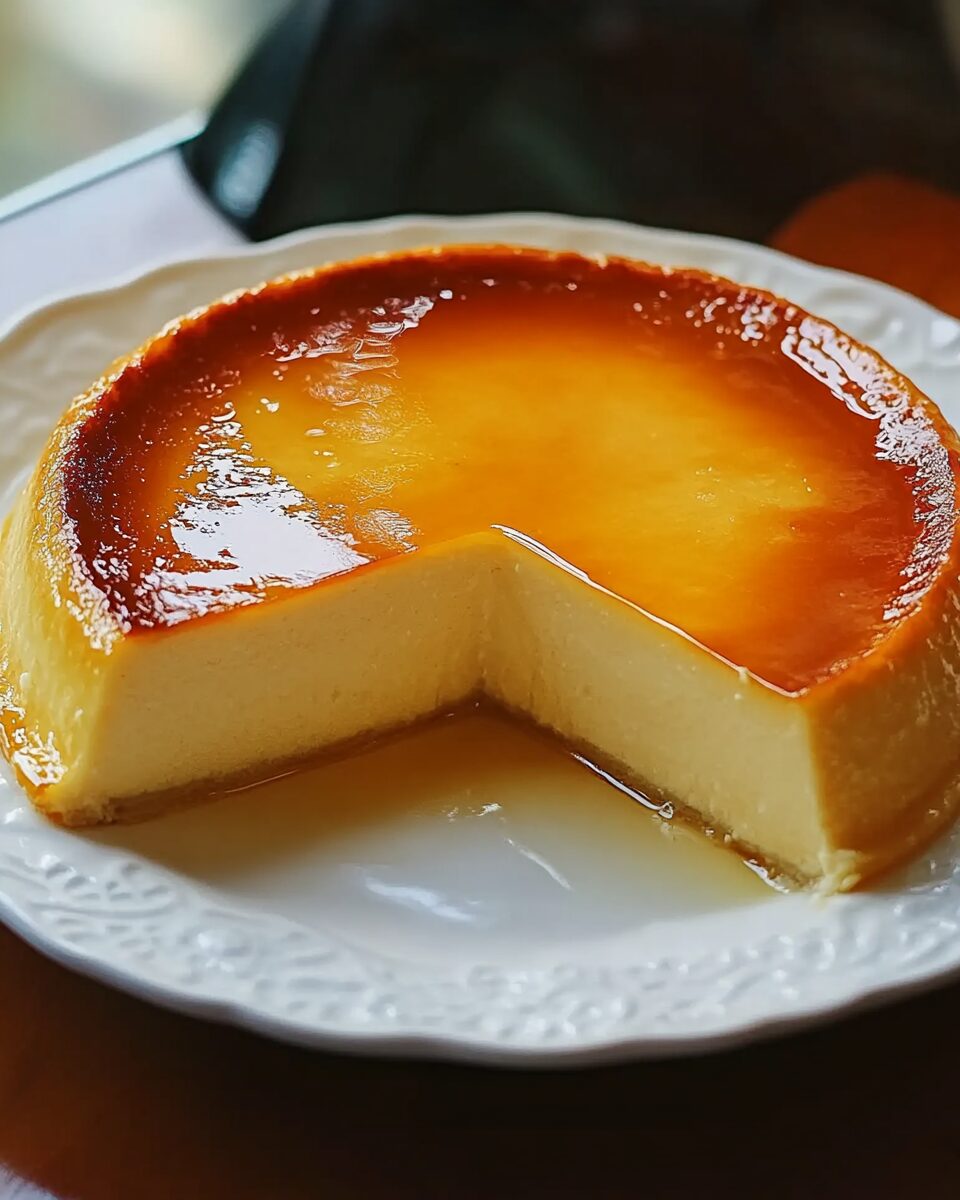Spanish Flan is a classic dessert known for its rich, creamy custard topped with a luscious layer of caramel sauce. Originating from Spain, this delightful treat has become a favorite in many cultures worldwide. Its smooth texture and sweet flavor make it a perfect conclusion to any meal.
Full Recipe:
Ingredients
- 1 cup white sugar
- 3 large eggs
- 1 (14-ounce) can sweetened condensed milk
- 1 (12 fluid ounce) can evaporated milk
- 1 tablespoon vanilla extract
Directions
- Prepare the Caramel: In a medium saucepan over medium-low heat, melt the sugar until it becomes liquefied and golden in color. Carefully pour the hot syrup into a deep 9-inch round glass baking dish, tilting to evenly coat the bottom. Set aside.
- Prepare the Custard: In a large bowl, beat the eggs. Add the sweetened condensed milk, evaporated milk, and vanilla extract; mix until smooth. Pour this mixture over the caramel-coated baking dish.
- Bake the Flan: Place the filled baking dish inside a larger roasting pan. Pour hot water into the roasting pan until it reaches halfway up the sides of the baking dish, creating a water bath. Bake at 350°F (175°C) for about 1 hour, or until the flan is set with a slight jiggle in the center.
- Cool and Serve: Remove the flan from the oven and water bath; let it cool to room temperature. Refrigerate for at least 3 hours. To serve, run a knife around the edges of the dish, invert onto a rimmed serving plate, and allow the caramel sauce to flow over the flan.
Nutritional Facts (Per Serving)
- Calories: 406
- Total Fat: 11g
- Saturated Fat: 6g
- Cholesterol: 106mg
- Sodium: 162mg
- Total Carbohydrates: 66g
- Dietary Fiber: 0g
- Sugars: 66g
- Protein: 11g
The History of Spanish Flan
Flan has a long and fascinating history that dates back to the Roman Empire. The Romans were among the first to develop recipes for custards, using eggs, milk, and honey. Over time, these recipes spread throughout Europe, eventually making their way to Spain, where the modern version of flan was perfected.
During Spain’s colonization of the Americas, flan was introduced to Latin America, where it quickly became a popular dessert. Each country developed its own variations, incorporating local flavors such as coconut, coffee, or even cheese. Today, flan is a staple dessert in countries like Mexico, Puerto Rico, and Cuba, where it is often enjoyed with a touch of cinnamon or citrus zest.
Why Spanish Flan is a Perfect Dessert
Flan is a universally loved dessert because of its delicate balance of sweetness, creaminess, and a hint of caramel bitterness. Here are some reasons why Spanish Flan is the perfect choice for any occasion:
- Elegant and Simple: Despite its sophisticated appearance, flan is incredibly easy to make with just a handful of ingredients.
- Rich Yet Light: The custard’s smooth texture makes it feel indulgent, but it is not overly heavy, making it an ideal dessert after a big meal.
- Versatile and Adaptable: While the classic recipe is delicious on its own, flan can be customized with different flavors and toppings.
- Perfect for Any Occasion: Whether served at a dinner party, a holiday gathering, or a casual family meal, flan is always a welcome treat.
- Make-Ahead Convenience: Flan is best when chilled for several hours, making it a perfect dessert to prepare in advance.
Different Variations of Flan
One of the great things about flan is its versatility. While the classic Spanish Flan is made with vanilla and caramel, there are many variations that incorporate different flavors and ingredients:
- Coconut Flan: Made with coconut milk or shredded coconut, this version has a tropical twist.
- Coffee Flan: Infused with espresso or coffee liqueur, this variation is perfect for coffee lovers.
- Chocolate Flan: Cocoa powder or melted chocolate is added to the custard for a rich, chocolatey flavor.
- Cheese Flan (Flan de Queso): Cream cheese is added to create a texture similar to cheesecake, making it extra creamy.
- Orange or Lemon Flan: Citrus zest or juice is incorporated for a refreshing, tangy twist.
- Pumpkin Flan: Popular during the fall season, this version includes pumpkin puree and warm spices like cinnamon and nutmeg.
No matter which variation you choose, the basic process remains the same, allowing for endless creativity and customization.
Pairing Suggestions for Flan
Flan is delicious on its own, but it can be enhanced with a few thoughtful pairings. Here are some great ways to serve flan:
- Fresh Fruit: Slices of strawberries, oranges, or berries add a refreshing contrast to the rich custard.
- Whipped Cream: A dollop of lightly sweetened whipped cream enhances the creaminess of the flan.
- Chocolate Drizzle: A light drizzle of chocolate sauce or ganache can complement the caramel flavor.
- Caramelized Nuts: Toasted almonds or pecans add a crunchy texture that pairs beautifully with the soft custard.
- Coffee or Espresso: The deep, roasted flavors of coffee balance the sweetness of the flan.
- Sweet Wine or Dessert Liqueurs: A glass of sweet white wine or a liqueur like Amaretto can elevate the dessert experience.
Pairing flan with complementary flavors and textures enhances the overall experience and makes it even more enjoyable.
How to Store and Serve Flan
Flan is a great make-ahead dessert because it needs time to chill and set properly. Here are some tips on how to store and serve it:
- Refrigeration: Flan should be stored in the refrigerator for at least 3-4 hours before serving. It can last up to 5 days when covered tightly with plastic wrap or stored in an airtight container.
- Serving Temperature: It is best served chilled, but letting it sit at room temperature for 10-15 minutes before serving allows the flavors to develop fully.
- Unmolding the Flan: To easily release the flan from its mold, run a knife around the edges, then place a serving plate on top and invert it quickly but carefully. The caramel sauce will flow over the custard, creating a beautiful presentation.
- Freezing: While flan can be frozen, its texture may change slightly upon thawing. If freezing, store it in an airtight container and thaw it in the refrigerator overnight before serving.
Following these storage and serving tips ensures that your flan remains as fresh and delicious as possible.
Health Considerations of Flan
Flan is a rich and indulgent dessert, but it does offer some nutritional benefits when enjoyed in moderation:
- Protein: The eggs in flan provide a good source of protein, which helps with muscle growth and repair.
- Calcium: Dairy ingredients like milk and condensed milk contribute to calcium intake, which is essential for bone health.
- Lower Sugar Options: To make a healthier version, you can reduce the sugar in the caramel or use a sugar substitute like stevia.
- Dairy-Free Alternatives: For those with lactose intolerance, flan can be made using coconut milk, almond milk, or oat milk.
Although flan is a treat, making small modifications can help make it a bit lighter while still keeping its delicious texture and flavor.
Conclusion
Spanish Flan is a classic dessert that has stood the test of time due to its creamy texture, rich caramel sauce, and elegant presentation. Its origins in Spain and its widespread popularity in Latin America and beyond make it a truly global dessert. The simple yet sophisticated combination of eggs, milk, sugar, and vanilla creates a custard that is both light and indulgent at the same time. What makes flan so special is its versatility. Whether enjoyed in its traditional form or with added flavors like coconut, coffee, or chocolate, this dessert can be adapted to suit any occasion. It pairs well with a variety of accompaniments, from fresh fruit to coffee, making it a well-rounded and satisfying treat.






